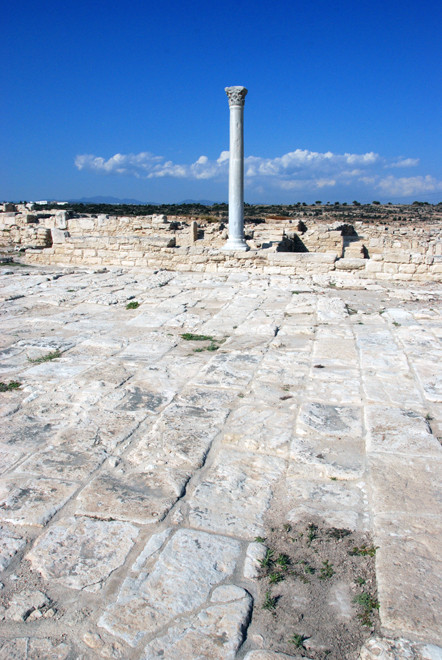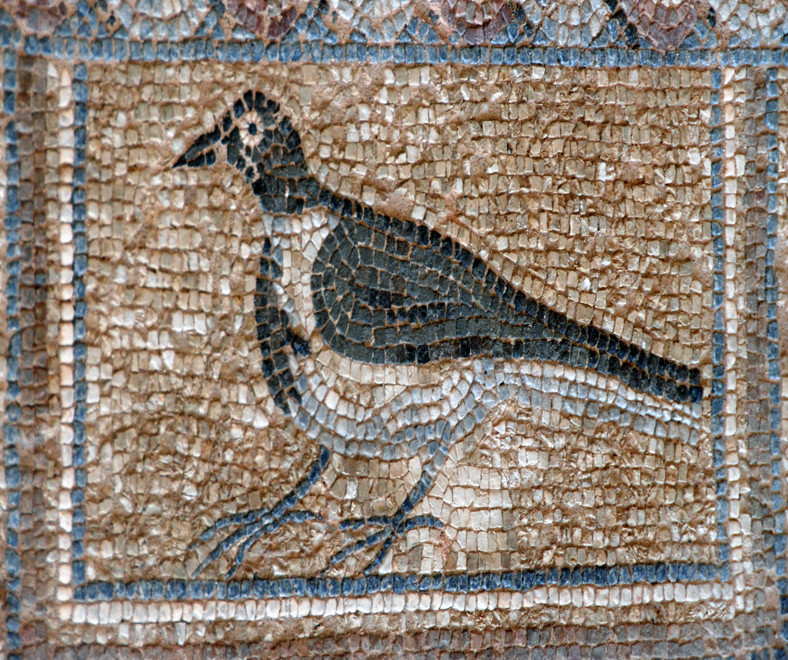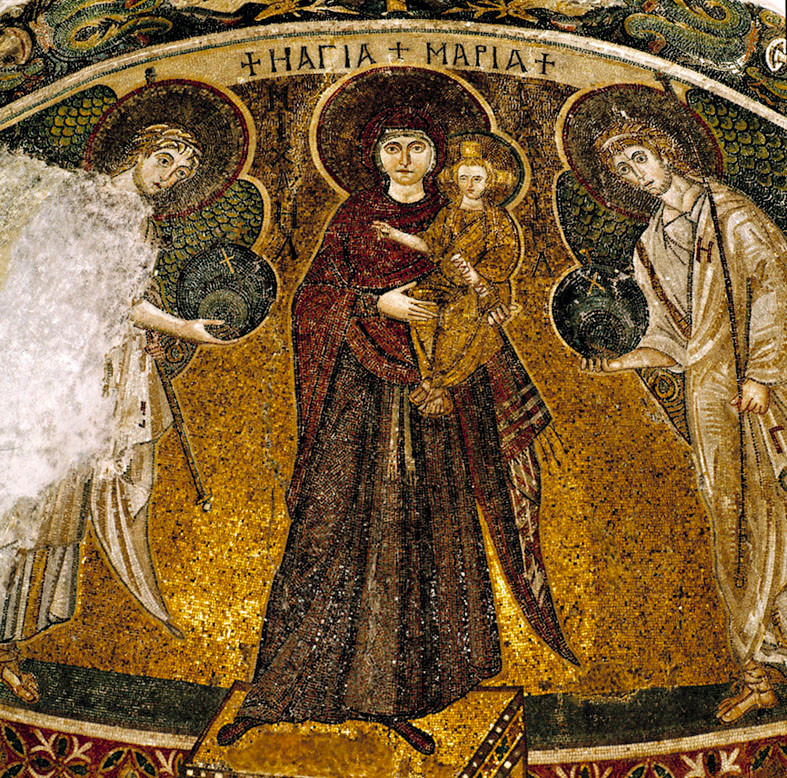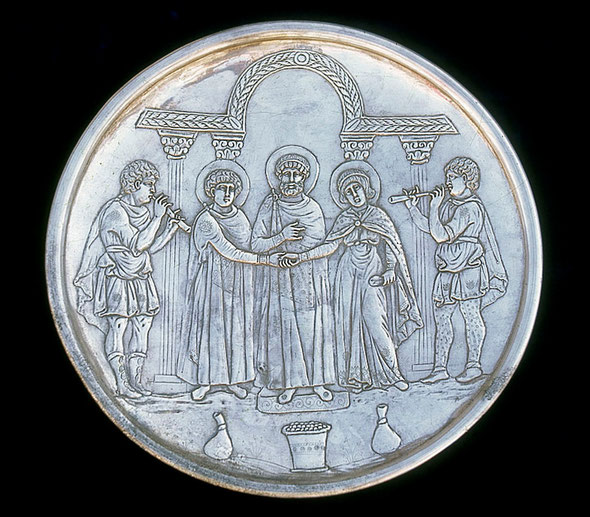VI. The Byzantine Empire and the Troodos Wall Paintings

A. The Orthodox Church in Cyprus in the Byzantine Empire
Christianity is said to have arrived in Cyprus in 45 AD and was evangelized by the apostles Paul and Barnabas (who came from Salamis). It was slow to spread across the island and was interrupted by Cyprus’s part in the Jewish Rebellion of 116AD that was eventually put down by Hadrian.
Following the division of the Roman Empire into eastern and western divisions in 284AD Cyprus was administered from Antioch(now in Turkey) until the 5th century, ‘when the opportune discovery of the relics of Barnabas provided justification of Cyprus’s ecclesiastic and civic autonomy, answerable only to the capital of the Eastern empire, Constantinople’ (Rough Guide p.374).
Fourth century Byzantine mosaics that can be traced back to the style being developed in Antioch were discovered at Kurion in the House of Eustolios that are linked to the reign of Emperor Theodisios II (408-450AD). At this time the writ of Christianity on the island was still weak as evidenced by the use of both Christian symbols and appeals to Appollo in the House of Eustolios.
Cyprus was decimated by earthquakes and droughts in first half of the fourth century. Aid came from the Constantine the Great’s heir, who helped establish a new city of Constantia (on the site of Salamis) that replaced Roman Paphos as the capital.
In 488AD Byzantine Emperor Zeno declared the Cyprus Church autocephalous (literally self-headed): from that point the Cypriot Orthodox Church was ruled by the Archbishop of Cyprus, who was not subject to any higher ecclesiastical authority, although his church remained in full communion (mutual recognition of shared doctrines) with the other Eastern Orthodox churches (Wikipedia: Autocephaly).
Cyprus was a province in the Byzantine Empire and suffered raids from the Arab caliphate during the seventh century that brought great destruction and were intended to neutralise Cyprus as a Byzantine stronghold while rendering its wealth up to the raiders.
Cyprus was jointly administered from 668 under the Arab-Byzantine Treaty by the Byzantine Empire and the caliphate as a condominium for 300 years. This demilitarized the island, obliged it to accept Muslim settlers and taxes were paid equally to the caliphate and the Byzantine empire. During this time Arab raids caused a movement from coastal settlements to the interior and the transfer of the capital to Nicosia.
In 965 Byzantine Emperor Nicephoros Phokas sent a fleet to repel further Arab raids and Cyprus became a Byzantine ‘theme’ or military province and was administered for two centuries by Byzantine officials. The island’s Muslims either left or converted to Christianity and two centuries of peace reigned. Taxes were high but the island’s silk and food trades prospered and the major cities - Kyrenia, Famagusta, Nicosia and Limassol – were founded or greatly expanded. At the same time, the Troodos redoubts of the Orthodox church began to be endowed by wealthy donors. The acclaimed wall paintings (they are not true frescoes) were produced between the 11th and 16th centuries (pp. 221 and 374-5 Rough Guide and Panteli, S., 2005,The History of Modern Cyprus).

B. The Troodos Wall Paintings
The wall paintings of the Troodos churches date from the beginning of the 12th century. In Byzantium the preceding century had been dominated by the so-called Macedonian Age and is widely regarded as the second golden age of Byzantine culture.
As is detailed on the previous page this Macedonian Age was characterized by a ‘wholly distinct style …in which a new interest in tenderness and intimacy and a new stress on humanism’ was beginning to appear (Rice, 1963 p.122).
This seems to have reinvigorated Byzantine art which was only slowly emerging from the Iconclast Age (726-843) that had pushed artistic styles towards a rather austere linear formalism and pictorial abstraction.
Cyprus itself had recently emerged from the ravages of the Omayyid and Abbbasid Caliphates and the heavy taxes imposed through the Arab-Byzantine Treaty. In 965 Emperor Nicephoros Phokas sent a fleet to repel further Arab raids and Cyprus became a Byzantine ‘theme’ or military province run for two centuries by Byzantine officials.
There has been a lively if in the end slightly fruitless debate between Byzantine scholars as to the significance of the Troodos church paintings in the canon of Byzantine artistic achievement. Some, like Rice, assert that the achievements of the Cypriot churches can be classified as ‘wholly provincial.’ Others see strong links with Constantinople and at least one church was decorated by a Constantinople artist (Theodore Apseudes at the Cave Monastery of St. Neophytos) – (see for example Weyl Carr 2008).
Others have argued that whilst the churches were those of a ‘backward province’ their very architectural difference pushed the wall-painting artists in new directions. Painted between the 11th and 16th centuries the wall paintings of the Troodos churches developed a particular style in response to the simplified architecture of the buildings themselves and their parishioners. The simple barn-like, pitch roofed churches deprived the church artists of the normal spaces in which to insert their murals or mosaics – there were no cupolas, pendentives or vaults. Instead the church artists developed an all-over style of cartoon-strip story-telling aimed at teaching the gospel to an audience of devout but illiterate and often hard-pressed peasants (see Marc Rubin in the Rough Guide, p.186).
The Unesco website says that the Troodos small churches and monasteries represent one of ‘the greatest concentrations of churches and monasteries in the Byzantine Empire’. Three distinctive periods of wall painting are present.

The first are those from the 12th century when the Empire was ruled by the Comnenes Emperors (1057-1185). These include the Asinou (Panagia Phorbiotissa of Nikitari), which can be traced back to 1105-06 and Panagia tou Arakou in Lagoudera, which was executed during the last six months of 1192. The site notes that ‘These paintings are the perfect expression of rudimental art [whatever that is] during the period of the Comnenes.’
13th and 14th-century painting is also represented by works of great quality in Nikitari, at the church of the Virgin in Moutoullas, and at St Heracleidius's, which is one of the twin churches of the Kalopanayotis monastery.
Lastly, there is post-Byzantine painting which, after the fall of the Empire, spread the artistic formulas of Constantinople. It is well represented by the narthex of the Kalopanayotis monastery, by the church of the Archangel Michael in Pedhoulas (1474), that of the Holy Cross, in Platanistasa (1494), etc.
The first serious study of the Troodos wall paintings took place in 1934 at Asinou, which was seen as a key
moment in mid-Byzantine art because of association records of patrons and a definite date – 1105/6. This was followed by a 1966 French publication which identified twenty two scenes from the New
Testament from original decoration as well as a number of full-length portraits of saints many of them rather obscure - Andronikos, Hilarion, Kyriakos, Anthony, Euphemios, Nikitas and
Sabbas (see D. Talbot Rice’s (1967) review of Sacopoulo (M.) ‘Asinou en 1106 et sa contribution 'a l’iconographie’ in The Journal of Hellenic Studies, Vol. 87).
Much at the same time the Dumbarton Oaks Research Library and Collection in Washington DC began a programme of cleaning and restoration of Byzantine wall paintings in Cyprus in collaboration with the Department of Antiquities and the Orthodox Church.
It can be argued that the significance of the Troodos churches and the restorations that have been carried out under the Dumbarton Oaks programme has shifted attention away from the perhaps stale typologising of icons towards an understanding of the artistic processes, variations and developments that allowed Byzantine artists ‘to work swiftly and with a high degree of clarity and mutual understanding.’
The grammar of painting that they possessed – through a mutually accepted system of composition, figure proportion and colour - allowed the artists to ‘give to a body of iconography the durable visual significance that it retains today’ (pp.1000-1001).
For this line of argument see A Weyl Carr's (2005) review of 'The Church of the Panaghia Tou Arakos at Lagoudhera, Cyprus: The Paintings and Their Painterly Significance' by D. Winfield and J. Winfield Speculum, Vol. 80, No. 3
In a recent paper Weyl Carr has argued for a two-pronged appreciation of the Cypriot Byzantine wall paintings.The first of these seems to place great
importance on the particular architectural limitiations of the humble Troodos churches:
‘A first and particularly provocative message of the Cypriot churches is the individual uniqueness of their iconographic programs. Byzantine programs are characteristically viewed as a series of variations upon the theme of Daphni, a classic church of the late-eleventh century in Greece. The Cypriot churches belie this. Though a hierarchic scheme does unite them, they exploit it in relentlessly particular ways. The more excellent the painter, the more distinctively inflected his program is.’
‘For example, the narthex at Asinou integrates the traditional image of the Pantokrator in the dome with an extensive iconographic program of the Last Judgment, its elements integrated into the pendentives and supporting arches with unique effectiveness’ (p.101).
The second theme that presses for a reading of the Troodos wallpaitings as distinctive draws on what Weyl Carr sees as the iterative and competing tendencies of a small grouping of artists working in close geographical proximity.
‘But perhaps the most interesting feature of the frescoed churches is their responsiveness to one another. …such interchanges of style and imagery allow one to watch the structures of Byzantine culture weave themselves into the imaginative processes of Cyprioit painters, patrons and viewers, creating in time a dense fabric of shared images and informed cross-references. It became a fabric so firm and solid that the shock of foreign [Lusignan] conquest could not seriously unravel it, and Byzantine conceptions continued to adorn the Cypriot churches of the Lusignan and subsequent centuries’ (p. 102).
See A. Weyl Carr (2008) 'Dumbarton Oaks and the Legacy of Byzantine Cyprus'
Near Eastern Archaeology, Vol. 71, No. 1/2.



